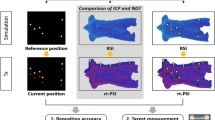Abstract
The stereotactic procedure in neurosurgery is a minimally invasive technique used to treat intracranial lesions. The fiducial markers of a frame-based stereotactic procedure are important for defining the stereotactic coordinate system and in locating the target. These markers are often defective in stereotactic images owing to the presence of air bubbles in the imaging indicator. We have assessed the effect of these defects on the registration of an image and on the localization of a target. The virtual phantom method was employed to simulate various types of defect. The virtual images were registered using the Leksell GammaPlan® (LGP) radiosurgery planning system, and the image definition and the target localization errors were assessed. As a result, the effect of the defects was most severe when the majority of the marker disappeared, but not all, especially in the posterior region. The mean and maximum image definition errors were 0.1 and 1.4 mm, which caused the mean target localization error to be 0.2 and 0.0 mm in LGP version 5.34 and 8.3.1, respectively. It is recommended to exclude images with defective fiducial markers during the image definition procedure to minimize subsequent errors, though the newest version of LGP (version 8.3.1) corrects localization errors.






Similar content being viewed by others
References
Baldwin LN, Wachowicz K, Thomas SD, Rivest R, Fallone BG (2007) Characterization, prediction, and correction of geometric distortion of 3T MR images. Med Phys 34:388–399
Barnett GH, Linskey ME, Adler JR, Cozzens JW, Friedman WA, Heilbrun MP, Lunsford LD, Schulder M, Sloan AE (2007) Stereotactic radiosurgery—an organized neurosurgery-sanctioned definition. J Neurosurg 106:1–5
Benedict SH, Bova FJ, Clark B, Goetsch SJ, Hinson WH, Leavitt DD, Schlesinger DJ, Yenice KM (2008) Anniversary paper: the role of medical physicists in developing stereotactic radiosurgery. Med Phys 35:4262–4277
Biggins TF (2008) Patient care in stereotactic radiosurgery. In: Chin LS, Regine WF (eds) Principles and practice of stereotactic radiosurgery. Springer, New York, pp 699–707
Burchiel KJ, Nguyen TT, Coombs BD, Szumoski J (1996) MRI distortion and stereotactic neurosurgery using the Cosman–Roberts–Wells and Leksell frames. Stereotact Funct Neurosurg 66:123–136
Chang SD, Main W, Martin DP, Gibbs IC, Heilbrun MP (2003) An analysis of the accuracy of the CyberKnife: a robotic frameless stereotactic radiosurgical system. Neurosurgery 52:140–147
Chung HT, Lee R (2008) Verification of indicator rotation correction function of a treatment planning program for stereotactic radiosurgery. J Korean Assoc Radiat Protect 33:47–51
Guo WY (1998) Application of MR in stereotactic radiosurgery. J Magn Reson Imaging 8:415–420
Hamilton RJ, Kuchnir FT, Sweeney PJ, Rubin SJ (1996) Repositioning accuracy of a noninvasive head fixation system for stereotactic radiotherapy. Med Phys 23:1909–1917
Hartov A, Roberts DW (2009) Accuracy in stereotactic and image guidance. In: Lozano AM, Gildenberg PL, Tasker RR (eds) Textbook of stereotactic and functional neurosurgery, 2nd edn. McGraw Hill, New York, pp 443–452
Heck B, Jess-Hempen A, Kreiner HJ, Schöpgens H, Mack A (2007) Accuracy and stability of positioning in radiosurgery: long term results of the Gamma Knife system. Med Phys 34:1487–1495
Hemm S, Wårdell K (2010) Stereotactic implantation of deep brain stimulation electrodes: a review of technical systems, methods and emerging tools. Med Biol Eng Comput 48:611–624
Leksell GammaPlan 8.3.1 Online Reference Manual (2008) Appendix F: Tomographic study definition. Elekta Instrument AB, Stockholm, p 323
Leksell L (1951) The stereotaxic method and radiosurgery of the brain. Acta Chir Scand 102:316–319
Leksell Stereotactic System® Instructions for Use (2008) Replenishing the marker channels. Elekta Instrument AB, Stockholm, pp 241–243
Lemieux L, Jagoe R (1994) Effect of fiducial marker localization on stereotactic target coordinate calculation in CT slices and radiographs. Phys Med Biol 39:1915–1928
Maciunas RJ, Galloway RL Jr, Latimer JW (1994) The application accuracy of stereotactic frames. Neurosurgery 35:682–695
Moerland MA, Beersma R, Bhagwandien R, Wijrdeman HK, Bakker CJ (1995) Analysis and correction of geometric distortions in 1.5 T magnetic resonance images for use in radiotherapy treatment planning. Phys Med Biol 40:1651–1654
Novotný J, Vymazal J, Liščák J, Vladyka V (1998) Assessment of the accuracy of stereotactic target localization using magnetic resonance imaging: a phantom study. J Radiosurg 1:99–111
Peters TM, Clark J, Pike B, Drangova M, Olivier A (1987) Stereotactic surgical planning with magnetic resonance imaging, digital subtraction angiography and computed tomography. Appl Neurophysiol 50:33–38
Roessler K, Ungersboeck K, Dietrich W, Aichholzer M, Hittmeir K, Matula C, Czech T, Koos WT (1997) Frameless stereotactic guided neurosurgery: clinical experience with an infrared based pointer device navigation system. Acta Neurochir 139:551–559
Siddon RL, Barth NH (1987) Stereotaxic localization of intracranial targets. Int J Radiat Oncol Biol Phys 13:1241–1246
Spetzger U, Laborde G, Gilsbach JM (1995) Frameless neuronavigation in modern neurosurgery. Minim Invasive Neurosurg 38:163–166
Wu A, Lindner G, Maitz AH, Kalend AM, Lunsford LD, Flickinger JC, Bloomer WD (1990) Physics of Gamma Knife approach on convergent beams in stereotactic radiosurgery. Int J Radiat Oncol Biol Phys 18:941–949
Yu C, Apuzzo M, Zee CS, Petrovich Z (2001) A phantom study of the geometric accuracy of computed tomographic and magnetic resonance imaging stereotactic localization with the Leksell stereotactic system. Neurosurgery 48:1092–1099
Acknowledgments
This work was supported by Nuclear Research & Development Program of the Korea Science and Engineering Foundation (KOSEF) grant funded by the Korean government (MEST). (grant code: M800-20100162).
Author information
Authors and Affiliations
Corresponding author
Rights and permissions
About this article
Cite this article
Park, JH., Han, J.H., Kim, CY. et al. Effect of fiducial marker defects on stereotactic target localization in the Leksell stereotactic system. Med Biol Eng Comput 49, 775–782 (2011). https://doi.org/10.1007/s11517-011-0773-8
Received:
Accepted:
Published:
Issue Date:
DOI: https://doi.org/10.1007/s11517-011-0773-8



